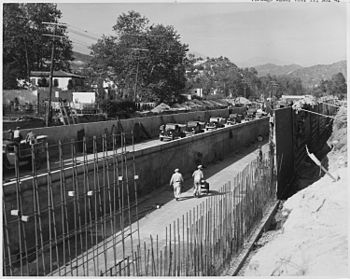Verdugo Wash facts for kids
Quick facts for kids Verdugo Wash |
|
|---|---|

Channelization work, 1936
|
|
| Country | United States |
| Physical characteristics | |
| Main source | Glendale, California 34°12′11″N 118°14′15″W / 34.203°N 118.2375°W |
| River mouth | Los Angeles River, California |

Verdugo Wash is a stream about 9.4-mile-long (15.1 km). It flows through the city of Glendale in Los Angeles County, California. This stream is a tributary of the famous Los Angeles River. A tributary is a smaller stream or river that flows into a larger one.
What is Verdugo Wash?
Verdugo Wash is not like a natural river you might imagine. Most of it is inside a concrete channel. This channel helps control floods. It guides the water safely through the city. This way, homes and businesses are protected from heavy rains.
Where Does Verdugo Wash Flow?
The stream starts near Interstate 210. This area is in the Crescenta Valley. From there, it flows southeast. It runs along the eastern side of the Verdugo Mountains.
Then, it turns south. It goes through a pass between the Verdugo Mountains and the San Rafael Hills. Finally, it flows west. It joins the Los Angeles River near Griffith Park. The entire path of Verdugo Wash is within the city of Glendale.
Why is it in a Concrete Channel?
The concrete channel is a flood control channel. This means it was built to manage water flow. It prevents flooding during heavy rains. Before these channels, areas could flood easily. Now, the water stays in the channel. This protects the communities nearby.
There is one small part of the stream that flows freely. This is inside the Verdugo Wash Debris Basin Dam. But most of the wash is a concrete waterway.

